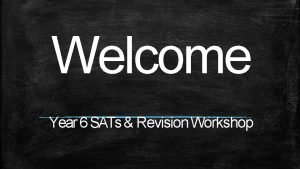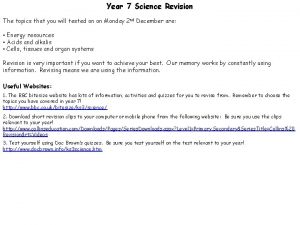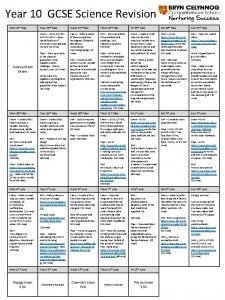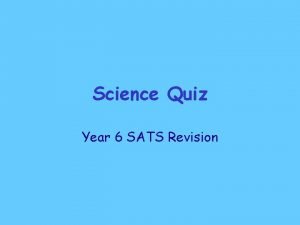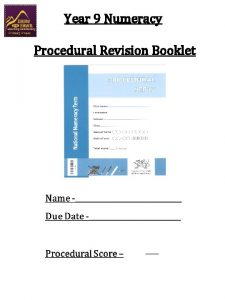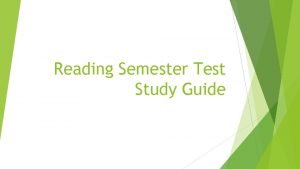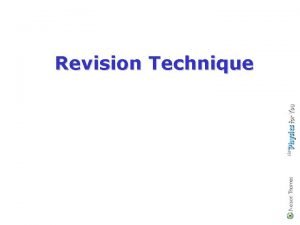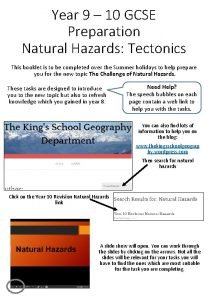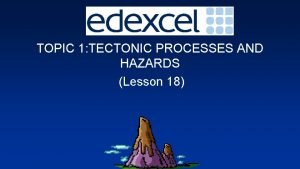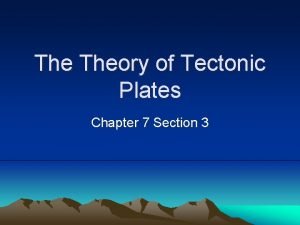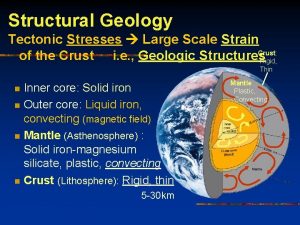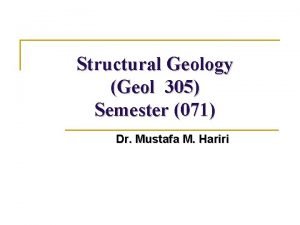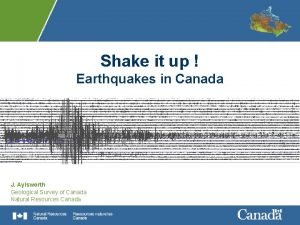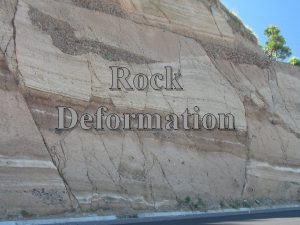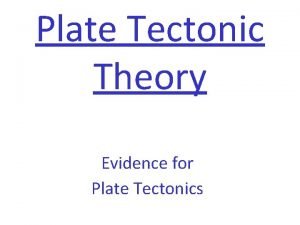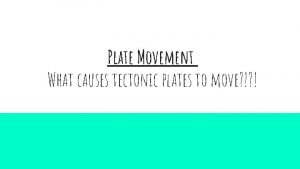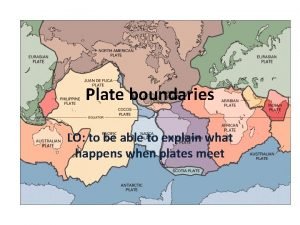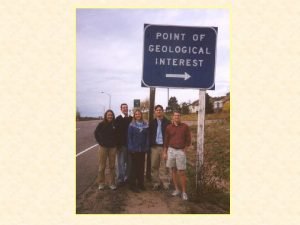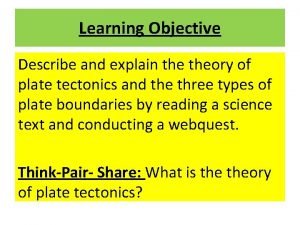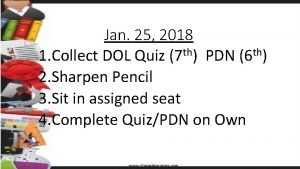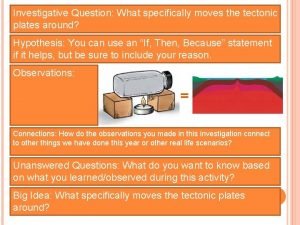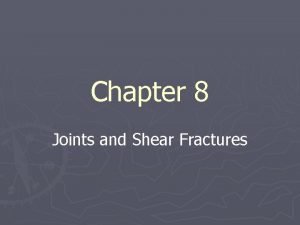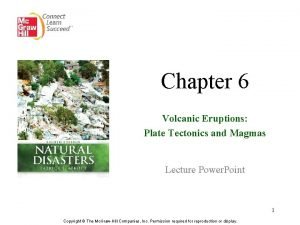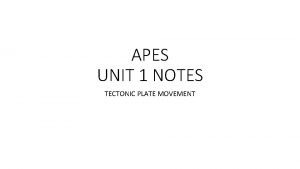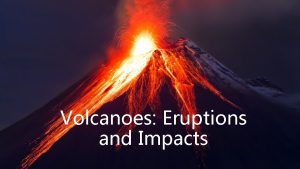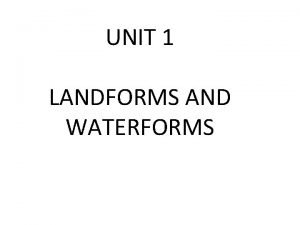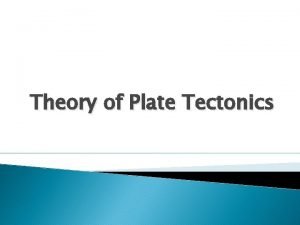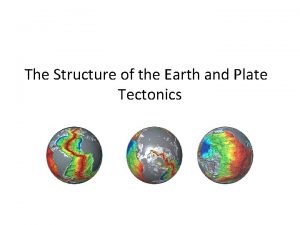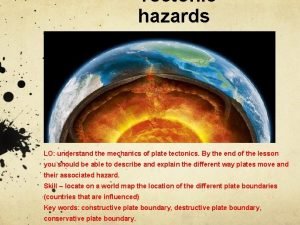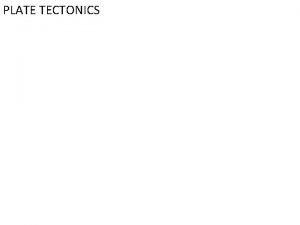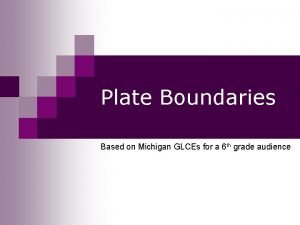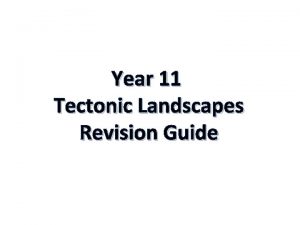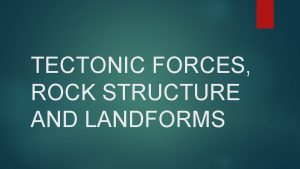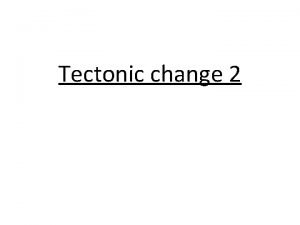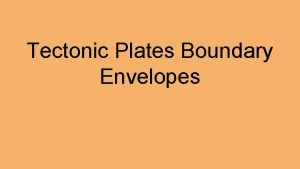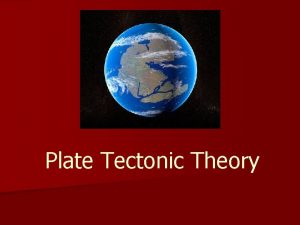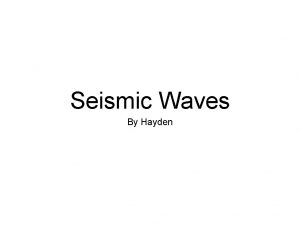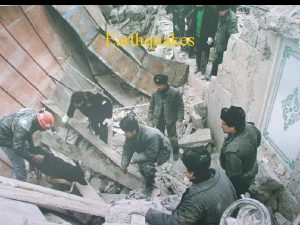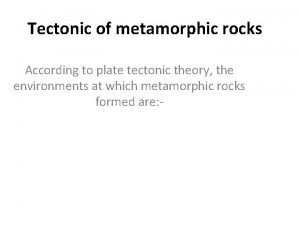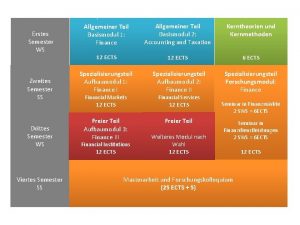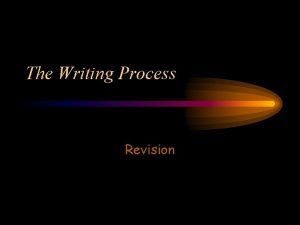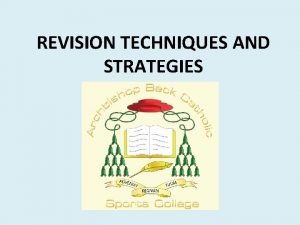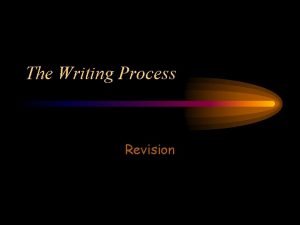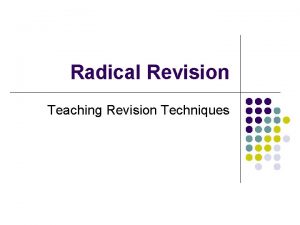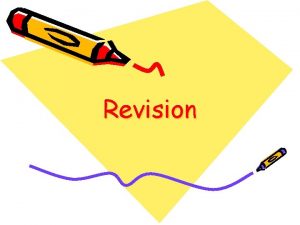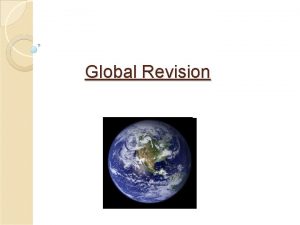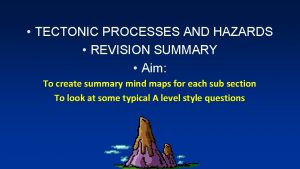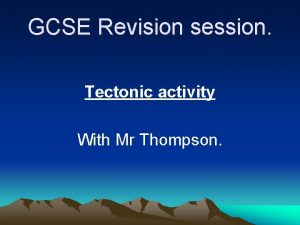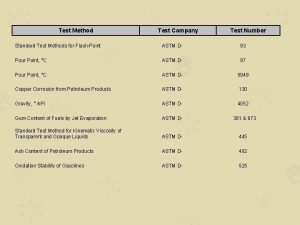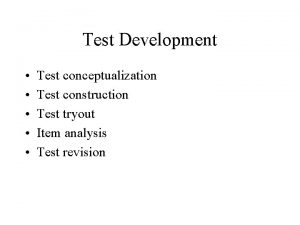Revision Year 3 Test 2 Semester A Tectonic









































- Slides: 41

Revision Year 3 Test 2 Semester A

Tectonic hazards

What is a hazard? It is an event, such as earthquakes and volcanic eruptions, which has the potential to cause loss of life or damage to property.

What happens in an earthquake? Earthquakes occur when the tension is released from inside the crust. This happens because plates do not move smoothly- sometimes they get stuck. When this happens a great deal of pressure builds up. Eventually this pressure is released an earthquake occurs.

. Focus and epicentre The seismic waves spread out from the focus. The strongest waves are found near the centre of the earthquake. This means that the most severe damage caused an earthquake will happen close to the epicenter- the point on the Earth’s surface directly above the focus.

Seismic waves are the vibrations from earthquakes that travel through the Earth; they are recorded on instruments called seismometers

The Richter scale The amount of energy released by an earthquake is called its magnitude.



10

What is the focus and epicentre of an earthquake? • The focus of an earthquake is its central pointthe point deep below the surface where the earthquake starts. Seismic waves are released and then spread in all directions. • The point on the surface directly above the focus is called the epicentre. It is the place on the surface that is nearest to the focus and therefore where the greatest effects will be felt. 11


Questions page 93

Activity 1 • When enough tension builds up in a rock it will suddenly give way, like an elastic band snapping. The result is a (sudden) earthquake.

Activity 2 a) Seismic waves are waves of energy given out during an earthquake; they pass through Earth in all directions and cause everything to shake. b) The focus of an earthquake is the point where the rock moved, setting the earthquake off. c) The epicentre of an earthquake is the point on Earth’s surface directly above the focus. d) The magnitude of an earthquake means how much energy it gives out; it is measured on the Richter scale.

Activity 4 a) At A, since it is nearer the epicentre. b) At B, since buildings can collapse and kill people. c) A lot more damage, since it releases a lot more energy. d) 30 times. e) At 5 am, since people will be asleep. By 10. 30 am, many will have left for work and home. That does not mean they are out of danger. But they will have more chance to protect themselves if they are awake, for example by moving away from windows, and following the emergency earthquake drill.

Activity 5 a) Chile is near the edge of the South American plate, close to where the heavier Nazca plate is sliding under it. So Chile has volcanoes, and many earthquakes. b) Chile is a long, narrow country. Its cities and towns are all close to the coast. So they would be badly affected by a large earthquake at the plate edge. Chile has been quite poor in the past, so it is likely that many homes were badly built, and could not survive being shaken. The earthquake also set off a tsunami, which destroyed homes along the coast. c) The earthquake set off a tsunami in the Pacific Ocean which travelled across the ocean, and drowned people in Japan. (It also drowned people in Hawaii and did extensive damage in Hawaii and Japan, and some damage on the west coast of the USA. )

2. 3 Predictions and prevention of the effects of an earthquake The effects of earthquakes are usually much greater in LEDCs – Less Economically Developed Countries (LICs – Low Income Countries) - than in MEDCs – More economically developed Countries (HICs – High Income Countries). Wealthy countries have good communications and can afford to stockpile emergency supplies of water, food, medicines and shelter. There is more money available to build earthquake-proof buildings.

Earthquake proof buildings

• 1 - Study Figure 23. What precautions can people take to protect themselves from earthquakes? (4) • 2 - Study Figure 24. It is suggestions given in Japan to help people prepare for earthquakes. • Fix heavy furniture to the walls • Have an emergency action plan • Have ready a first aid kit, torches and batteries • Prepare a telephone list of the emergency services Choose two of the suggestions. Explain why each of these suggestions is a good idea. (4)

• Predicting earthquakes is a seismologist’s dream since this would allow people to evacuate the danger areas before the event. Although there have been some advances in earthquake prediction in China, Japan and the USA, the major recent earthquakes in these areas were not forecast. Scientists may pinpoint areas at risk and predict the probability of an earthquake occurring, but not precisely when this will happen.

• 3 - Instructions are also given on what to do during an earthquake. Study Figure 25. An earthquake is happening in each of these cartoons. • Circle the person or car driver in each cartoon who is being sensible. Annotate Figure 25 to justify your answers.


Case study of an earthquake




Activities page 95 An earthquake in Southwest China

Activity 1 • It is in Asia, in the southwest of China.

Activity 3 • Points to include: • Indo-Australian plate collides with the Eurasian • Fault develops • Strain forced the rock to slip downwards • It slipped as much as 12 meters

Activity 5 a) The red represents the area with the most severe shaking. b) They are both the same distance from the epicentre, but Mianyang is closer to the fault line along which the rock slipped downwards. c) About 250 km.

Activity 6 • There will be more earthquakes, because the plates are still moving and pushing against each other.

Activity 7 • Most deaths have been caused by buildings collapsing. (Some may have been caused by fires, or by roads collapsing. ) So most could have been prevented, if the buildings had been stronger, and earthquake-proofed.

Tsunamis • What is a tsunami? • It is a giant wave or series of large waves in the ocean created by major shallow-water earthquakes and/or submarine landslides.

26 December, 2004 • The worst tsunami disaster in living history was caused by an earthquake in the Indian Ocean off the island of Sumatra measuring 9. 3 on the Richter Scale.

• More than 300 000 people (many of them European holiday makers) were killed in eight Asiatic countries (in particular Indonesia/Sumatra, Sri Lanka, India, Thailand, Myanmar, Maldives, Malaysia and Bangladesh). The tidal wave even reached coastlines several thousand kilometres away, like East and Southeast Africa. There were also casualties in Somalia, Tanzania, Kenya, Madagascar and the Seychelles.

Activities page 97 Tsunami!

Activity 1 • It’s caused by an earthquake in the ocean floor (which is caused by plate movements), or giant landslide.

Activity 2 a) Many countries border the Indian Ocean. The waves travelled across the ocean in all directions, and reached over a dozen of them. b) Some countries were further from the epicentre than others, so it took longer for the waves to reach them. c) The epicentre was very close to Indonesia. Somalia was thousands of kilometres away. The waves lost energy as they travelled, so they did less damage in Somalia. d) The waves may be only one metre high out at sea, and in many ocean –going boats you would notice this. The waves slow down and grow taller in the shallower water at the coast. e) The Philippines were sheltered from the tsunami by Thailand Indonesia.

Activity 3 • Earthquakes shake buildings and other structures, and people are killed when these collapse. • Tsunami waves rush onto the land with great force, and can wash away buildings, but also drown people far from buildings, and wash away crops, farm animals, and other forms of livelihood. • There are some things you can do to protect yourself during an earthquake. There is little you can do to protect yourself from an approaching tsunami if you are in its path.

Activity 5 • The buoys give out signals to satellites and these can transmit them very rapidly to places along vulnerable coastlines, giving people a chance to move away from the coast. • (The buoys collect data from pressure sensors on the ocean floor, which can detect tiny changes in wave pressure. )
 Revision passive voice
Revision passive voice Year 7 spanish test
Year 7 spanish test Sats 2019 timetable
Sats 2019 timetable Year 7 science revision
Year 7 science revision Year 7 french homework booklet
Year 7 french homework booklet Year 10 science revision
Year 10 science revision Keeping healthy quiz
Keeping healthy quiz Year 9 maths revision booklet
Year 9 maths revision booklet Environmental science final study guide
Environmental science final study guide 13.05 semester test american literature part 1
13.05 semester test american literature part 1 Letnji semestar
Letnji semestar Leavers assembly poems
Leavers assembly poems Whats wrong with this picture
Whats wrong with this picture Primary and secondary effects of a tectonic hazard
Primary and secondary effects of a tectonic hazard Ring of fire tectonic plates
Ring of fire tectonic plates Primary and secondary effects of a tectonic hazard
Primary and secondary effects of a tectonic hazard Hazard profile examples
Hazard profile examples Continental drift vs plate tectonics theory
Continental drift vs plate tectonics theory What is the main cause of tectonic plate movement
What is the main cause of tectonic plate movement Tectonic joints
Tectonic joints Tectonic joints
Tectonic joints Grand banks earthquake of 1929
Grand banks earthquake of 1929 Tectonic joints
Tectonic joints Evidence for pangea
Evidence for pangea Plate tectonics vs continental drift
Plate tectonics vs continental drift Tectonic movement
Tectonic movement Blank tectonic plate map
Blank tectonic plate map Oreo plate boundaries
Oreo plate boundaries Mount fuji tectonic plates
Mount fuji tectonic plates Transform fault
Transform fault Tectonic plates with names
Tectonic plates with names Investigative question
Investigative question Unloading joints
Unloading joints Stratovolcano tectonic setting
Stratovolcano tectonic setting Plate boundaries apes
Plate boundaries apes Tectonic plates bbc bitesize
Tectonic plates bbc bitesize Tectonic plates
Tectonic plates Tectonic plates interact at places called plate
Tectonic plates interact at places called plate Tectonic plates move
Tectonic plates move Collision plate margin diagram
Collision plate margin diagram Convergent boundary divergent boundary transform boundary
Convergent boundary divergent boundary transform boundary Glces
Glces


